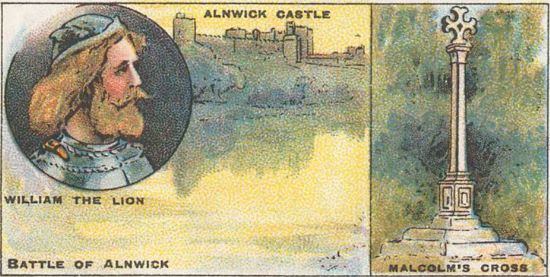|

William I the Lion of Scotland 1142-1214
William I, known as William the Lion, reigned as King of Scots from 1165 to 1214,
making his reign one of the longest in Scottish history.
|
|
Image Above
Battle of Alnwick, William the Lion, Alnwick Castle, Malcolm's Cross.
NY Public Library Digital Collections
|
Early Life and Ascension
Born around 1142 or 1143, he was the son of Henry, Earl of Northumberland,
and Ada de Warenne.
He ascended to the throne following the death of his brother, Malcolm IV,
on December 9, 1165, and was crowned shortly thereafter on December 24, 1165, at Scone Abbey in Perthshire.
William's early life was marked by significant political upheaval. After losing the Earldom of
Northumbria to  Henry II of England in 1157, he became heir presumptive to the Scottish throne.
Henry II of England in 1157, he became heir presumptive to the Scottish throne.
His reign began under challenging circumstances as he sought to reclaim lost territories,
particularly in Northumbria, which had been a point of contention between Scotland and England.
King William I the Lion's Reign
:: Revolt Against Henry II 1173-1174 ::
William played a pivotal role in the Revolt against Henry II, also called the
 Anglo-Norman Rebellion, the
Anglo-Norman War, or the Great Rebellion,
aligning himself with Henry's
sons who were rebelling against their father. In 1174, during a raid at the Battle of Alnwick,
William was captured after charging into battle and was taken prisoner to England. This defeat
led to significant consequences for Scotland.
Anglo-Norman Rebellion, the
Anglo-Norman War, or the Great Rebellion,
aligning himself with Henry's
sons who were rebelling against their father. In 1174, during a raid at the Battle of Alnwick,
William was captured after charging into battle and was taken prisoner to England. This defeat
led to significant consequences for Scotland.
Here is the map:

Map of the Great Rebellion:
the Second Battle of Alnwick
:: Treaty of Falaise 1174 ::
To regain his freedom and retain his kingship, William signed the Treaty of Falaise, which
required him to acknowledge Henry II as his feudal superior and pay substantial taxes to cover
the costs of the English occupation of Scotland. This treaty effectively placed Scotland under
English control for about 15 years.
:: Restoration of Sovereignty 1189 ::
Following Henry II's death, William negotiated with his successor,
 Richard I, to buy back Scotland's
sovereignty for 10,000 silver marks. However, this transaction did not immediately grant Scotland full independence.
Richard I, to buy back Scotland's
sovereignty for 10,000 silver marks. However, this transaction did not immediately grant Scotland full independence.
The recognition of Scotland's sovereignty was a complex and gradual process influenced by subsequent events and treaties.
Scotland's independence was formally recognized later in the 14th century, particularly with the
Treaty of Edinburgh in 1328, which acknowledged
 Robert the Bruce as king of an independent Scotland.
Robert the Bruce as king of an independent Scotland.
King William I the Lion's Death
William died on December 4, 1214, in Stirling and was buried at Arbroath Abbey. He was succeeded by his son,
Alexander II.
Despite his tumultuous relationship with English monarchs and periods of subjugation, William's reign is remembered for its
resilience and contributions to the development of Scotland as a nation.
King William I the Lion's Legacy
William I is credited with various contributions to Scottish governance and culture.
- He established several royal burghs and extended the use of sheriffs, enhancing administrative efficiency across Scotland.
- He founded Arbroath Abbey, which later became famous for the
Declaration of Arbroath in 1320, asserting Scotland's independence.
- His heraldic symbol, the red lion rampant on a yellow background, became associated with Scottish royalty and is still used
today as a national emblem.
More Maps

1152-1327 England and France

Anglo-Norman Rebellion 1173-1174: First
Scottish Invasion

Anglo-Norman Rebellion 1173-1174: Richard de
Lucy's Response

Anglo-Norman Rebellion 1173-1174: Leicester's
Invasion

Anglo-Norman Rebellion 1173-1174: Second
Scottish Invasion
See also the chart
 Governments of Britain.
Governments of Britain.
More History
|